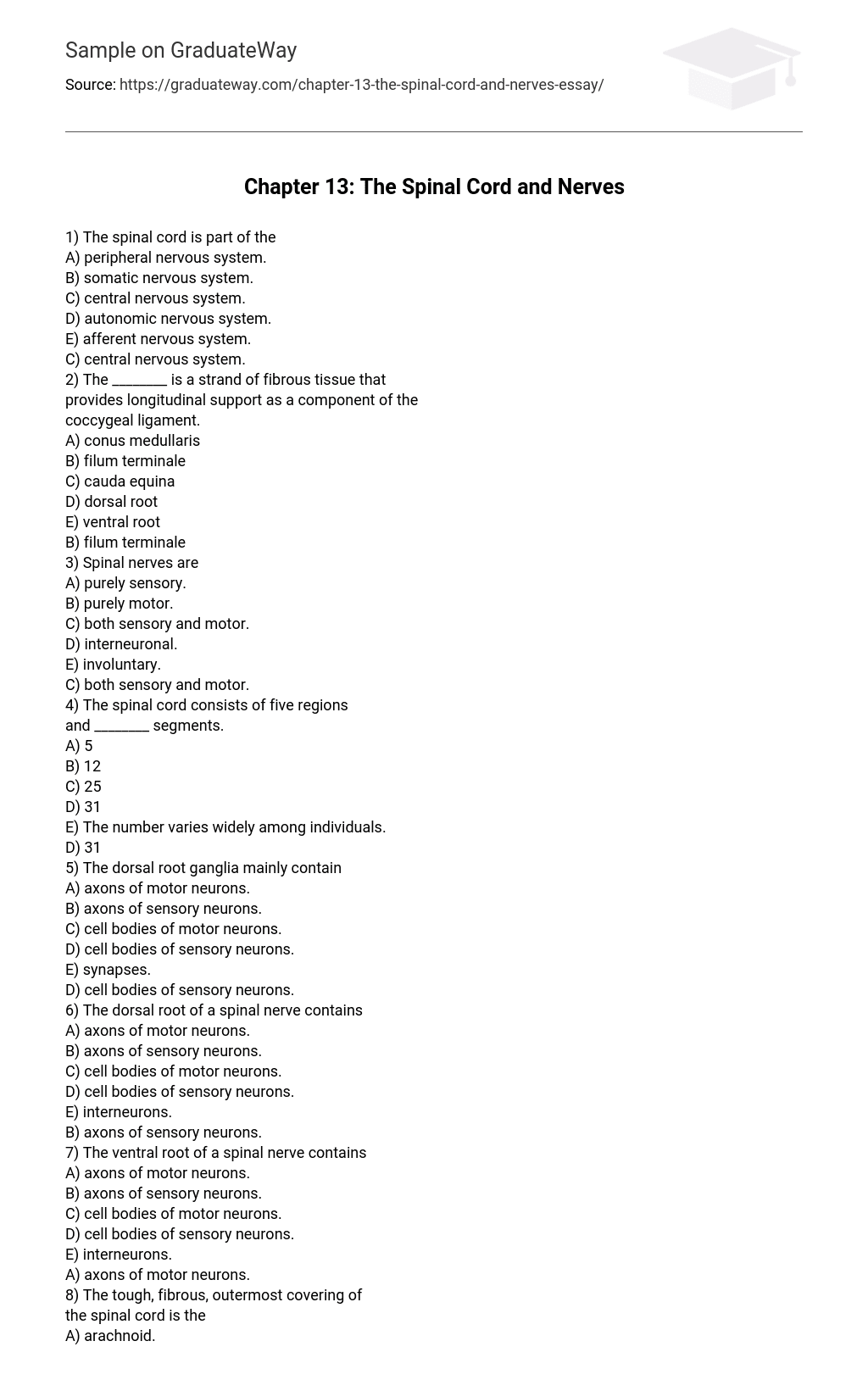A) peripheral nervous system.
B) somatic nervous system.
C) central nervous system.
D) autonomic nervous system.
E) afferent nervous system.
provides longitudinal support as a component of the
coccygeal ligament.
A) conus medullaris
B) filum terminale
C) cauda equina
D) dorsal root
E) ventral root
A) purely sensory.
B) purely motor.
C) both sensory and motor.
D) interneuronal.
E) involuntary.
and ________ segments.
A) 5
B) 12
C) 25
D) 31
E) The number varies widely among individuals.
A) axons of motor neurons.
B) axons of sensory neurons.
C) cell bodies of motor neurons.
D) cell bodies of sensory neurons.
E) synapses.
A) axons of motor neurons.
B) axons of sensory neurons.
C) cell bodies of motor neurons.
D) cell bodies of sensory neurons.
E) interneurons.
A) axons of motor neurons.
B) axons of sensory neurons.
C) cell bodies of motor neurons.
D) cell bodies of sensory neurons.
E) interneurons.
the spinal cord is the
A) arachnoid.
B) pia mater.
C) dura mater.
D) epidural block.
E) periosteum.
A) 8
B) 12
C) 18
D) 4
E) 1
A) output to skeletal muscles would be blocked.
B) output to visceral organs would be blocked.
C) the spinal cord would not be able to process information at that level.
D) the brain would not be able to communicate with that level of the spinal cord.
E) sensory input would be blocked.
A) the arachnoid mater and the pia mater.
B) the pia mater and the dura mater.
C) the dura mater and the arachnoid mater.
D) the pia mater and the subarachnoid space.
E) the endosteum and the periosteum.
the
A) dura mater.
B) subarachnoid space.
C) arachnoid.
D) pia mater.
E) choroid plexus.
A) cervical enlargement.
B) lumbar enlargement.
C) spinal nerve.
D) spinal meninx.
E) spinal ganglion.
A) inflammation of the meninges occurs.
B) bacteria can be the cause.
C) viruses can be the cause.
D) CSF flow can be disrupted.
E) All of the answers are correct.
A) It is commonly used as a method of pain control during labor and delivery.
B) It affects only the spinal nerves in the immediate area of the injection.
C) It can provide sensory and motor anesthesia, depending on the anesthetic selected.
D) It can provide mainly sensory anesthesia, depending on the anesthetic selected.
E) All of the answers are correct.
A) filum terminale.
B) subarachnoid space.
C) dura mater.
D) pia mater.
E) arachnoid mater.
A) 20 years.
B) 10 years.
C) 4 years.
D) 6 months.
E) 2 months.
A) cranial meninges.
B) cranial mater.
C) spinal meninges.
D) spinal mater.
E) epidural membranes.
A) pia mater.
B) dura mater.
C) epidural space.
D) subdural space.
E) subarachnoid space.
A) dura mater.
B) arachnoid mater.
C) epidural space.
D) subarachnoid space.
E) cerebral ventricles.
A) T6.
B) T10.
C) L1.
D) L5.
E) C1.
A) loss of sensation in his torso
B) inability to breathe
C) problems with moving his arms
D) uncontrollable sweating of his feet
E) problems with moving his legs
A) unmyelinated axons.
B) neuroglia.
C) Schwann cells.
D) myelinated and unmyelinated axons.
E) nodes of Ranvier.
A) nerve tracts.
B) columns.
C) meninges.
D) nerve cell bodies.
E) funiculi.
A) sensory nuclei.
B) somatic motor nuclei.
C) autonomic motor nuclei.
D) nerve tracts.
E) sympathetic nuclei.
A) sensory nuclei.
B) somatic motor nuclei.
C) autonomic motor nuclei.
D) nerve tracts.
E) sympathetic nuclei.
A) central canal.
B) posterior gray horns.
C) gray commissures.
D) white columns.
E) anterior gray horns.
A) nuclei.
B) ganglia.
C) columns.
D) nerves.
E) horns.
A) wings.
B) horns.
C) pyramids.
D) fibers.
E) tracts.
A) anterior gray horns.
B) lateral gray horns.
C) posterior gray horns.
D) gray commissures.
E) white commissures.
A) bundles of axons with common origins, destinations, and functions.
B) bundles of dendrites with common origins, destinations, and functions.
C) sensory and motor nuclei.
D) both axons and dendrites.
E) interneurons.
32) Identify the structure labeled “1.”
A) anterior white column
B) lateral white column
C) lateral white horn
D) median commissure
E) posterior white column
33) Identify the structure labeled “4.”
A) posterior gray column
B) dorsal gray ganglion
C) posterior white column
D) posterior gray horn
E) anterior gray horn
34) Identify the structure labeled “10.”
A) anterior white commissure
B) anterior median fissure
C) anterior white column
D) anterior gray commissure
E) anterior white horn
35) What is the function of the structure labeled “12”?
A) control of skeletal muscle
B) somatic sensory receiving
C) visceral sensory receiving
D) control of visceral effectors
E) ascending pathway
36) What is the function of the structure labeled “14”?
A) control of skeletal muscle
B) somatic sensory processing
C) control of visceral effectors
D) somatic motor control
E) visceral sensory processing
37) Where do somatic motor neurons reside?
A) 10
B) 12
C) 13
D) 14
E) 15
38) Where are the white columns of the spinal cord?
A) 4, 5, 6
B) 1, 2, 3
C) 7, 11
D) 12, 13
E) 8
A) endoneurium.
B) endomysium.
C) perineurium.
D) epineurium.
E) epimysium.
A) white rami communicantes.
B) gray rami communicantes.
C) dorsal ramus.
D) ventral ramus.
E) dermatomes.
A) white rami communicantes.
B) gray rami communicantes.
C) dorsal ramus.
D) ventral ramus.
E) dermatomes.
A) dorsal rami.
B) ventral rami.
C) white rami.
D) gray rami.
E) sympathetic nerves.
A) 8 cervical spinal nerves
B) 11 thoracic spinal nerves
C) 5 lumbar spinal nerves
D) 5 sacral spinal nerves
E) 1 coccygeal spinal nerve
A) white ramus communicantes
B) gray ramus communicantes
C) dorsal ramus
D) ventral ramus
E) dermatome
A) cervical
B) thoracic
C) lumbar
D) sacral
E) coccygeal
A) cervical
B) brachial
C) lumbar
D) sacral
E) thoracic
A) cranial
B) cervical
C) brachial
D) lumbar
E) sacral
A) myasthenia gravis
B) neuronal damage
C) shingles
D) chickenpox
E) Hodgkin’s disease
A) perineurium.
B) epineurium.
C) endoneurium.
D) epimysium.
E) endosteum.
A) shoulder
B) intercostal
C) abdominal
D) leg
E) facial





